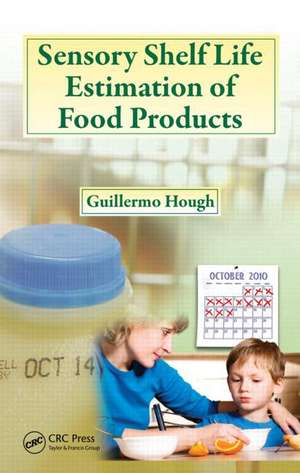Sensory Shelf Life Estimation of Food Products
Autor Guillermo Houghen Limba Engleză Hardback – 25 mai 2010
The book delineates the basics of sensory analysis and how it applies to shelf-life studies and includes discussions of experimental design aspects, survival analysis methodology, and its extensions. It provides detailed instructions and software functions for performing SSL estimations, accompanied by data sets and the R Statistical Package functions that are available for download. The author presents the cut-off point methodology used to estimate SSL when the survival analysis methods get complicated. He includes a chapter on accelerated storage covering kinetics, calculations of prediction confidence intervals and potential pitfalls. He also examines extensions of survival analysis statistics to other areas of food quality such as optimum concentration of ingredients and optimum cooking temperatures.
Microbiologically stable foods, such as biscuits or mayonnaise, will have their shelf-life defined by the changes in their sensory properties. Many fresh foods, such as yogurt or pasta, after relatively prolonged storage may be microbiologically safe to eat but rejected due to changes in their sensory properties. Shelf life in most food products is determined by sensory issues instead of microbiological or chemical concerns. This book offers key techniques for experimental design, storage, consumer testing procedures, and calculations. It includes methods for accelerated storage experiments, thoroughly explains statistical data treatment, and includes practical examples.
Preț: 1331.76 lei
Preț vechi: 1624.10 lei
-18% Nou
Puncte Express: 1998
Preț estimativ în valută:
254.87€ • 265.10$ • 210.41£
254.87€ • 265.10$ • 210.41£
Carte tipărită la comandă
Livrare economică 14-28 aprilie
Preluare comenzi: 021 569.72.76
Specificații
ISBN-13: 9781420092912
ISBN-10: 142009291X
Pagini: 264
Ilustrații: 63 b/w images, 38 tables and approx 59 equations
Dimensiuni: 156 x 234 x 23 mm
Greutate: 0.59 kg
Ediția:New.
Editura: CRC Press
Colecția CRC Press
ISBN-10: 142009291X
Pagini: 264
Ilustrații: 63 b/w images, 38 tables and approx 59 equations
Dimensiuni: 156 x 234 x 23 mm
Greutate: 0.59 kg
Ediția:New.
Editura: CRC Press
Colecția CRC Press
Public țintă
ProfessionalCuprins
Introduction. Principles of Sensory Evaluation. Design of Sensory Shelf Life Experiments. Basic Application of Survival Analysis to Sensory Shelf Life. Analysis of Covariates Affecting SSL. Cut-Off Point Methodology. Accelerated Storage for SSL Predictions. Other Applications of Survival Analysis in Food Quality.
Notă biografică
A research scientist with the Commission de Ivestigaciones Cientificas, Guillermo Hough is a renowned academic in sensory/consumer sciences. Dr. Hough conducts his research in the area of sensory science and has become an expert in the field of sensory shelf life, having published 20 refereed articles on this theme. A dynamic speaker at international conferences and symposiums, he also lead the collaborative Ibero-American project (CYTED program), which stated the basics for the estimation and modelization of sensory shelf life. His course on sensory science and shelf life has been very popular in Argentina, Chile, Colombia, Italy, Mexico, New York and Paris. His group is in close contact with local and regional food companies, performing a wide range of sensory tests and panel testing. Dr. Hough works at the Instituto Superior Experimental de Tecnologia Alimentaria in the small town of Nueve de Julio, Provincia de Buenos Aires, Argentina.
Descriere
A delineation of the basics of sensory analysis and how it applies to shelf-life studies, this book includes discussions of experimental design aspects, survival analysis methodology, and its extensions. It provides detailed instructions and software functions for performing SSL estimations, accompanied by data sets and the R Statistical Package functions that are available for download. The author presents the cut-off point methodology used to estimate SSL when the survival analysis methods get complicated. He includes a chapter on accelerated storage covering kinetics, calculations of prediction confidence intervals and potential pitfalls.

























